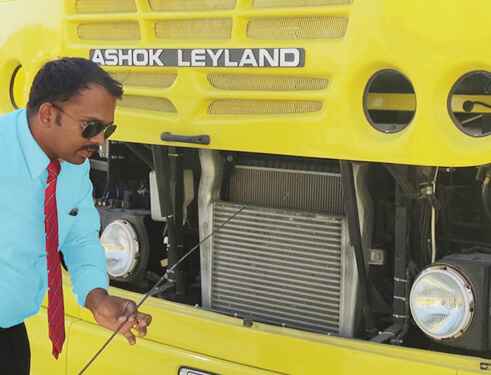Pre-trip Inspection
Driver vehicle inspections are an important part of the overall safe operation of a School Bus. A quality pre-trip inspection by a Driver can identify a defective equipment before it fails and saves the Driver, the School and Guardian One Transport from expensive roadside repairs, property damage, down time and fines.
Objective
The main objectives of conducting pre-trip inspections are to ensure the School buses are safe to operate, prevent loss to people and property, and prevent un-manifested items being placed on board and to ensure strict compliance to regulatory requirements
Safety Precaution by Drivers
During the pre-trip inspection, the school bus driver should use the following safety precautions:
- Do not get under, in front or behind the school bus as chances are it will move
- The school bus Driver should keep the ignition key under his control at all times
- Ensure that wheel chocks are used on inclines
- Use care while entering and exiting the vehicle
- Use three points of contact and make note of the foot and handholds
- Never jump out of or off a school bus
Pre-trip Inspection Guidelines
The bus Driver must thoroughly perform an inspection of his bus each time that it is put into service. The bus attendant assigned to the route must assist the bus driver. The following are the activities to be carried out during pre-trip inspection:
- Check and inspect the bus in the morning and again when the bus is back into service in the return trip in the afternoon even if nothing was noted wrong the night before or after the morning runs.
- Complete the Pre-Trip Inspection Form each time and get it checked with your team leader, even if you find nothing wrong with your bus.
- If defect(s) is found the driver must note each problem and/or malfunction on the Pre-Trip form and submit it to the foreman immediately, who in turn will send the vehicle to the workshop for mechanic’s review.
- In case the vehicle cannot be used for the assigned trip, notify your foreman and transport supervisor immediately who will coordinate and arrange for replacement bus. The driver should ensure to inspect and carry out a Pre-Trip inspection for the spare bus also.
- Never drive a bus if you find something wrong with it unless the mechanic clears the driver to do so. We might compromise on student safety, their lives, or cause a violation of traffic laws. Performing a proper pre-trip could possibly keep the driver out of a crash or keep him from being stranded on the road.
Procedure for a Pre-trip Inspection of the School
Bus
The school bus Driver should carry out a pre-trip inspection of the school bus commencement of each trip. The Pre-trip Inspection of the school bus is carried out in the following sequence:
- Approaching the school bus
- Check from the driver’s seat
- Checking switches and interior controls / indicators
- Checking of all emergency equipment’s
- Walk around outside
- Inside bus check
- Departure
While Approaching the School Bus
The Driver must check the exterior of the bus for
- Vandalism
- Damage
- Defaced color, debris such as broken glass, bottles, nails, flat tires, open/broken windows, doors or hood.
- Checking of all emergency equipments
- Broken lens covers and reflectors
From the Driver’s Seat
- Adjust the seat so that the steering wheel, brake pedal, accelerator, and all controls can be reached comfortably.
- Adjust the seat belt.
- Check windshield, side windows, and mirrors for cleanliness and cracks.
- Check all mirrors for proper adjustment. If needed, ask for assistance to adjust or tighten mirrors
- Student overhead, inside, rearview
- Right and left side Flat mirrors
- Right and left side convex mirrors
- Right and left side cross view mirrors
- Check operation of service door and latch, either manual or air-equipped
- Make sure parking brake is applied
- Turn key to activate the ignition switch, and “Wait to Start” light comes on and goes off before starting bus.
- Make sure transmission lever is in “N” (neutral) position.
- Check that air conditioner is off.
- Start engine. Never accelerate: let it warm up at idle.
Check switches and interior controls/indicators
- Horn
- Washers and wipers, high and low. See if wiping cleanly.
- Dome lights, turn on and off
- Headlights, low beam, high beam.
- Activate master switch, then check amber student lights, then red student lights and flashing stop signs
- Turn signal: Indicator Light check left and right, four-way emergency flashers, check indicator, leave on
- Clearance and running lights: turn on with headlights
- Check air conditioning system. Leave on if warm
Emergency Equipments
- Fire extinguisher
- First aid kit
- Belt cutter
- Emergency door opener
Tyres
- Check pressure
- Check tires for cuts, damage, bubbles, and tread wear.
- Check hub seals for leaks
- Check lug nut bolts for looseness, distortion, rust, or missing
- Check rims for cracks or dents
- Check outside side-view and convex mirrors, must be securely mounted and clean
- Hood latches secure.
- Lens covers securely mounted, not cracked, clean
- Wiper blades flush mounted, soft and flexible
Front
- Red student warning lights, flashing and clean lens covers not cracked or missing
- Clearance lights, clean; lens cover in place
- Lettering legible
- Four-way emergency flasher, clean and flashing
- Headlights, functions and clean
- Crossover mirrors, securely mounted and clean
- Safety guard crossing arm, extended and at right angle to bumper
- Parking lights and lens covers.
Driver’s Left Side
- Battery box door, closed and secure
- Two warning stop arms, extended with red lights flashing
- Clearance Lights, working, clean.
- Lettering, legible
- Reflector: clean, not missing, not cracked
- Tires and rims on rear axle: check same as front.
- Check spacing between tires, no objects between tires
- Side emergency door, if equipped. Open and close securely
Rear of Bus
- Rear lights, illuminated and clean. No cracked or missing lens covers
- Red student warning lights—flashing and clean
- Clearance lights, working and clean
- Four–way emergency flashers, working and clean
- License plate and light – in place, working, and clean
- Lettering, legible
- Emergency door, open wide from outside, closes securely. Glass clean, not cracked
- Exhaust pipe, tap foot lightly on pipe to verify, securely mounted
- Check for damage
- Strobe light flashing
Driver’s Right Side
- Same as left side
- Fuel tank cap, securely mounted
- Service door- moves on track, glass intact and clean
- Handrail is secure. Rubber mat is securely screwed down on the steps
- Stairwell light is working
- Lift buses: Check lift door and lift for proper functioning
- Sunwin or MCV buses: cargo doors closed securely
Front Light Check
- Driver’s seat: Leave engine running and parking brake on
- Close door and latch
- De-activate four-way flashers and switch student warning lights to amber: stop arms should retract
- Front: Amber Student warning lights, flashing amber Right turn signal. Left turn signal.
- Low beam, leave on low
Rear Light Check
- Student warning lights, flashing amber
- Brake lights
- Backup lights
- Note: Ask bus attendant or co-worker for assistance in checking rear student warning, brake, and backup lights.
- Bus Drivers are never to leave the driver’s seat with the engine running and the bus in gear, even if the parking brake on
Right Front Tires
- Check pressure
- Check tires for cuts, damage, bubbles, and tread wear.
- Check hub seals for leaks
- Check lug nut bolts for looseness, distortion, rust, or missing
- Check rims for cracks or dents
- Check outside side-view and convex mirrors, must be securely mounted and clean
- Hood latches secure.
- Lens covers securely mounted, not cracked, clean
- Wiper blades flush mounted, soft and flexible
Front
- Red student warning lights, flashing and clean lens covers not cracked or missing
- Clearance lights, clean; lens cover in place
- Lettering legible
- Four-way emergency flasher, clean and flashing
- Headlights, functions and clean
- Crossover mirrors, securely mounted and clean
- Safety guard crossing arm, extended and at right angle to bumper
- Parking lights and lens covers.
Left Driver’s Side
- Battery box door, closed and secure
- Two warning stop arms, extended with red lights flashing
- Clearance Lights, working, clean.
- Lettering, legible
- Reflector: clean, not missing, not cracked
- Tires and rims on rear axle: check same as front.
- Check spacing between tires, no objects between tires
- Side emergency door, if equipped. Open and close securely
Rear of Bus
- Rear lights, illuminated and clean. No cracked or missing lens covers
- Red student warning lights—flashing and clean
- Clearance lights, working and clean
- Four–way emergency flashers, working and clean
- License plate and light – in place, working, and clean
- Lettering, legible
- Emergency door, open wide from outside, closes securely. Glass clean, not cracked
- Exhaust pipe, tap foot lightly on pipe to verify, securely mounted
- Check for damage
- Strobe light flashing
Right Side of Bus
- Same as left side
- Fuel tank cap, securely mounted
- Service door- moves on track, glass intact and clean
- Handrail is secure. Rubber mat is securely screwed down on the steps
- Stairwell light is working
- Lift buses: Check lift door and lift for proper functioning
- Sunwin or MCV buses: cargo doors closed securely
Walk Down Aisle-Check
- General cleanliness of bus
- Front of seat backs and seat cushions for damage, need for repair, and for looseness
- Seat cushions and frames for looseness
- Seat belts in buses for tears, cuts, twisting, and wear; keep the seat belts ready to use condition.
- Rear windows for cleanliness
- Rear emergency door or emergency window opener
- Remove No Passenger Board & scan before commencement of the trip
Walk Up Aisle-Check
- Seat backs for damage or need for repair
- Seat backs for looseness
- Window on both sides, condition of latches, cleanliness
- Emergency roof hatches: open and close; ensure availability of emergency window opener
- Side emergency door, if equipped: open wide and check

